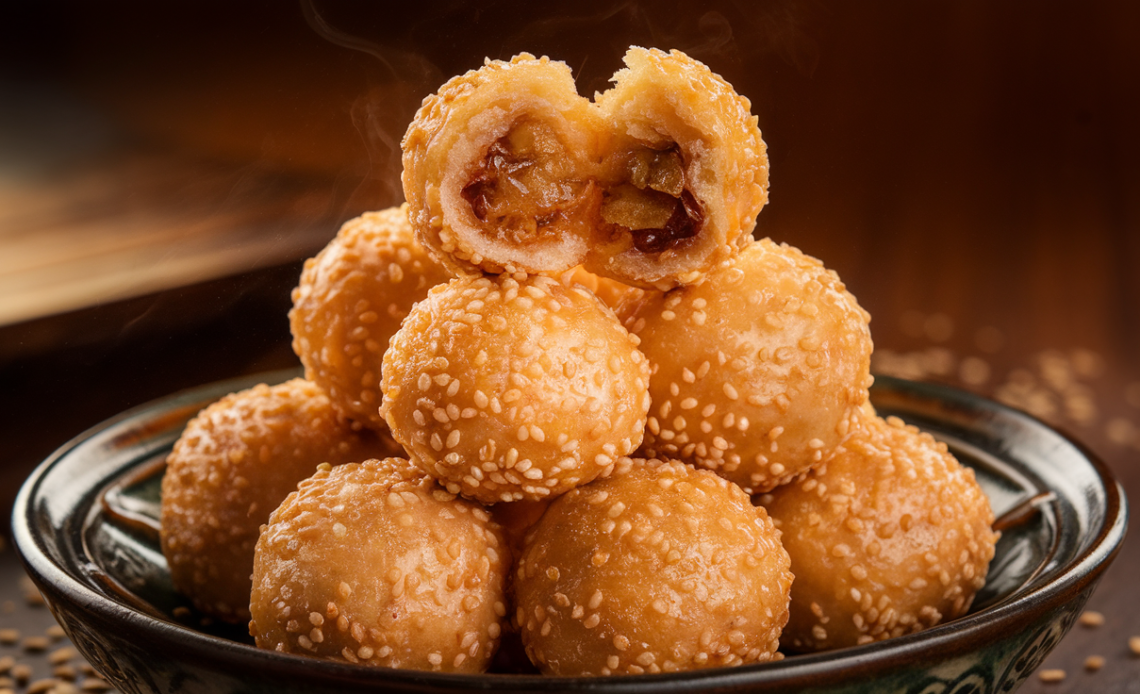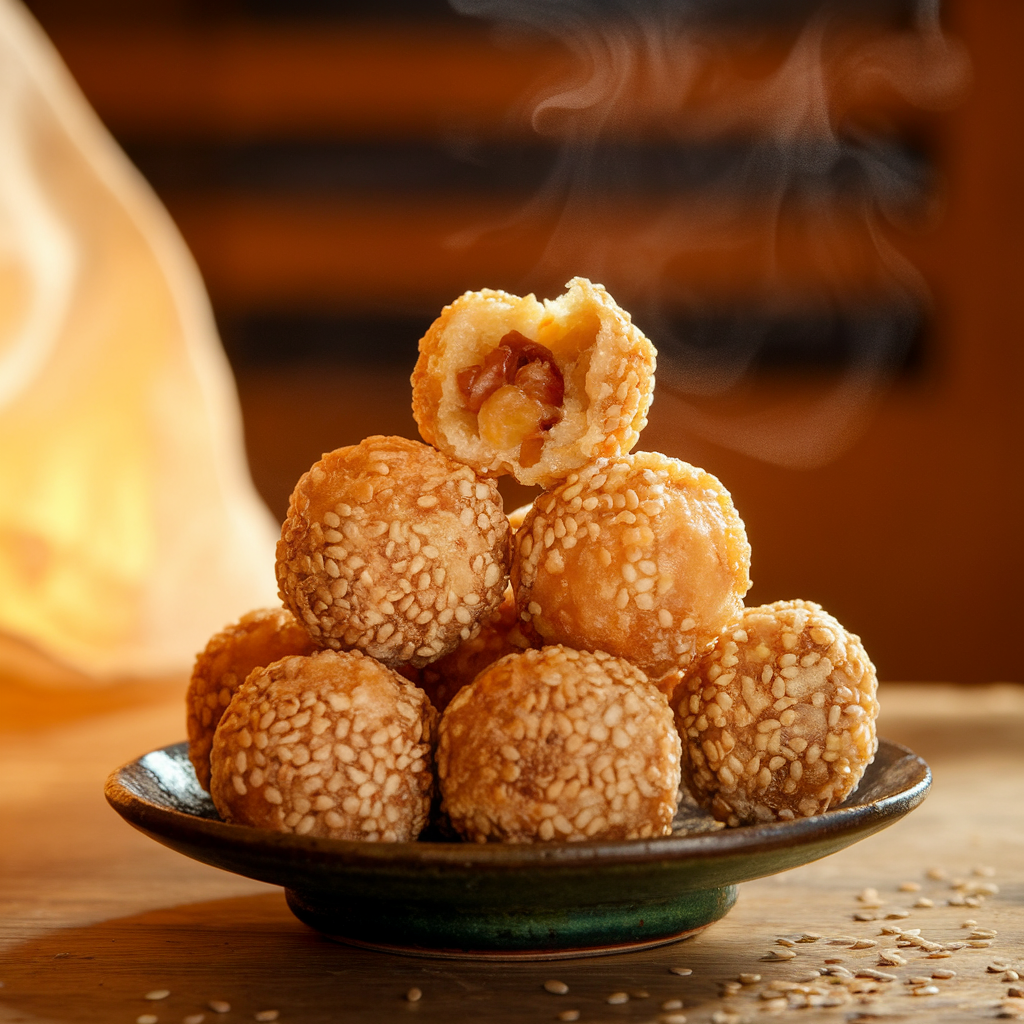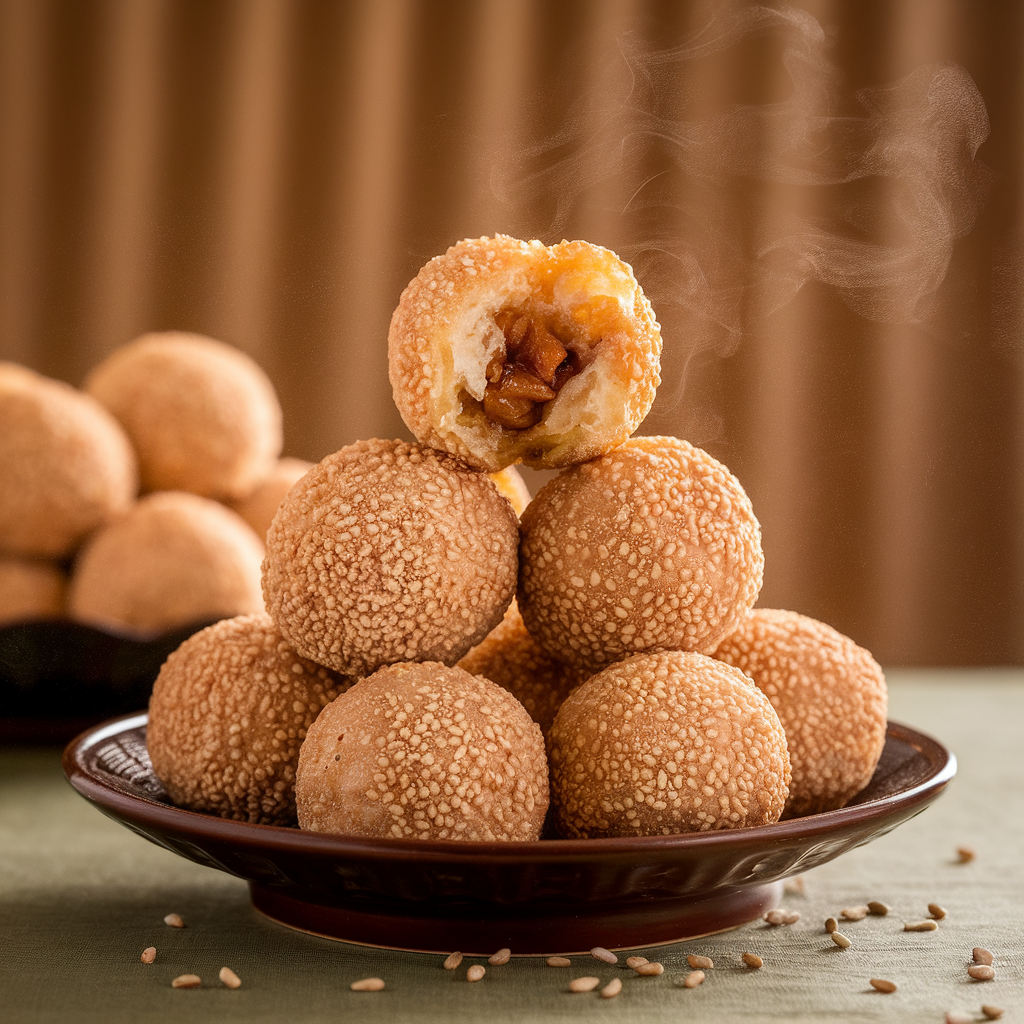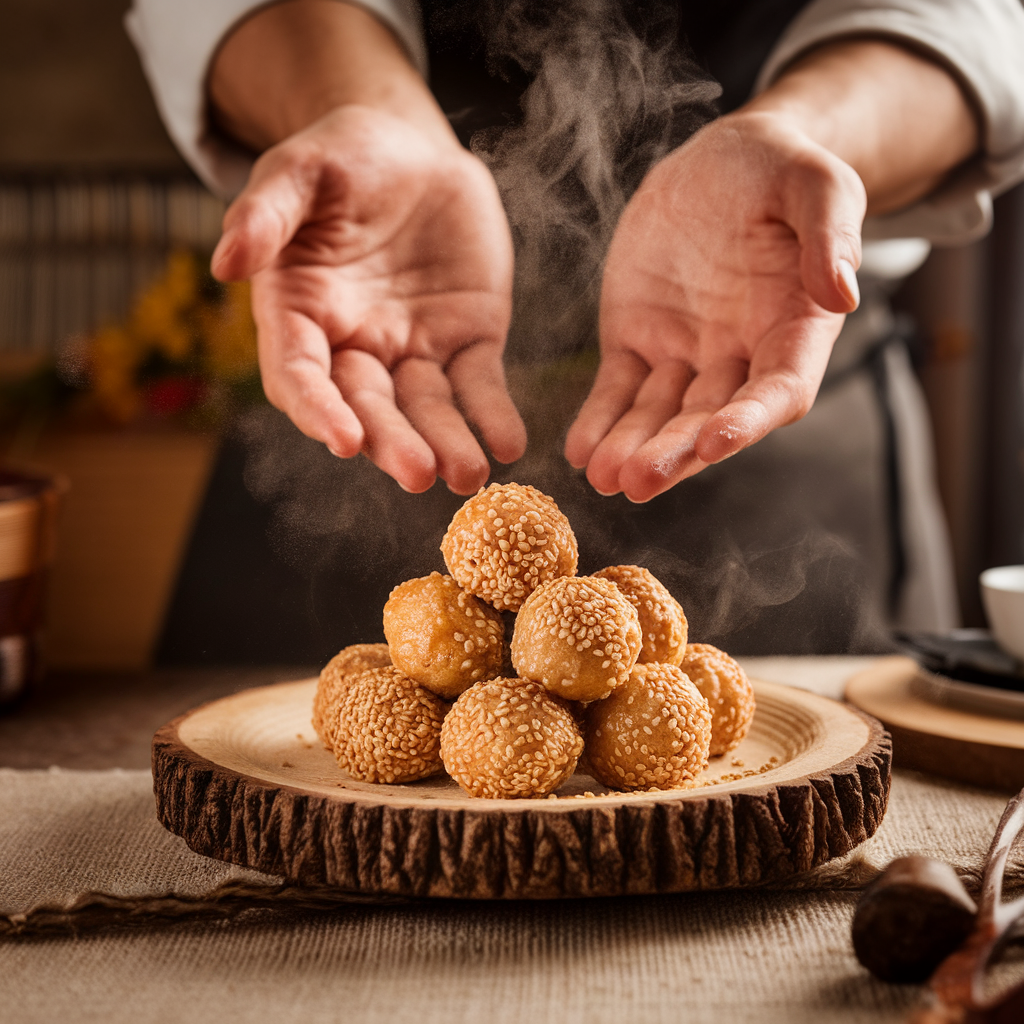
Jian Dui (煎堆), also known as Chinese Sesame Seed Balls, is a traditional dessert that brings joy with every bite. Crispy on the outside, chewy in the middle, and filled with sweet red bean paste, these golden balls are a popular treat served during festivals, dim sum brunches, and special occasions. Whether you know them as sesame balls, jin deui, or zhen dai, their irresistible texture and nutty-sweet flavor make them a favorite across cultures.
In this article, we’ll dive into everything you need to know about making the perfect Jian Dui at home—from ingredients and techniques to tips for achieving that signature puff and crackly crunch. Plus, we’ll explore the cultural significance of this iconic Chinese dessert and how it compares to other food in ball shape from around the world.
What Are Jian Dui?
Jian Dui are deep-fried glutinous rice balls coated in sesame seeds and typically filled with sweet bean paste—most commonly red bean paste (anko). They are known for their golden exterior and chewy texture, a contrast that makes them an absolute delight to eat.
You might recognize them from your local dim sum restaurant or Asian bakery. Their spherical shape and crunchy sesame seed crust hide a warm, sweet, slightly earthy filling that’s deeply satisfying. They are commonly enjoyed during Chinese New Year, symbolizing prosperity and happiness due to their golden color and round, full shape.
Ingredients for Jian Dui
Here’s what you’ll need to make about 12 sesame balls:
For the Dough:
- 1 cup glutinous rice flour (not regular rice flour)
- ¼ cup sugar
- ½ cup hot water (not boiling, just hot enough to dissolve sugar)
- 1 tablespoon vegetable oil
For the Filling:
- ½ cup sweet red bean paste (store-bought or homemade)
- Optional: lotus seed paste or black sesame paste as alternative fillings
For the Coating:
- ½ cup white sesame seeds
- Water (for moistening the dough before coating)
For Frying:
- Neutral oil (like canola, vegetable, or peanut oil) for deep frying

Step-by-Step Instructions
Step 1: Make the Dough
- In a mixing bowl, dissolve the sugar in the hot water.
- Add the glutinous rice flour gradually while mixing. Stir until the dough begins to come together.
- Add the oil and knead the dough until it forms a smooth, soft ball. It should be pliable but not sticky.
- Cover with a damp cloth and let rest for 15 minutes.
🔪 Pro Tip: If the dough is too dry, add water a teaspoon at a time. If it’s too sticky, sprinkle a little more flour.
Step 2: Prepare the Filling
- Take small teaspoons of red bean paste and roll them into 12 equal balls.
- Chill the filling balls in the freezer for 10–15 minutes to firm up. This makes them easier to wrap with the dough.
🍬 Red Bean Filling Tip: For a smoother texture, use fine red bean paste. If you like a chunkier center, try the coarse type.
Step 3: Assemble the Sesame Balls
- Divide the dough into 12 equal portions.
- Flatten each piece into a disc and place a red bean paste ball in the center.
- Gently wrap the dough around the filling and pinch to seal. Roll into a smooth ball between your palms.
🎯 Perfect Shape Tip: Try to make the ball as round and seamless as possible to help with even frying and a beautiful puff.
Step 4: Coat with Sesame Seeds
- Lightly moisten each dough ball with water.
- Roll in a bowl of sesame seeds until fully coated.
- Press gently to ensure the sesame seeds stick well.
🌱 Sesame Coating Tip: Toast the sesame seeds slightly beforehand for a deeper nutty flavor.
Step 5: Fry the Jian Dui
- Heat oil in a deep pot or wok to about 300°F (150°C). Use a thermometer for best results.
- Gently lower the sesame balls into the oil, 3–4 at a time.
- Fry slowly, stirring gently to rotate the balls for even cooking. This can take 8–10 minutes.
- Increase heat slightly in the final minutes to crisp the outer shell.
- Remove and drain on paper towels.
⚠️ Frying Tip: The secret to that iconic puff is frying low and slow. Too hot, and they’ll brown before puffing. Keep the oil moving gently with a slotted spoon.

Why Do Jian Dui Puff Up?
The puffing effect comes from steam expanding within the glutinous dough. As the water evaporates, the inner portion of the dough stretches the outer crust, causing it to balloon. A slow and steady fry ensures the inside gets hot enough to create this steam without burning the outside.
Variations and Fillings
While red bean sesame balls are the classic version, Jian Dui can be filled with other sweet or savory ingredients:
- Lotus Seed Paste: Creamier and subtly sweet.
- Black Sesame Paste: Rich, nutty, and deep in flavor.
- Sweet Taro Paste: Mild and starchy with floral undertones.
- Peanut Butter + Sugar Mix: A crunchy, kid-friendly twist.
- Savory Minced Meat: Found in some Southeast Asian versions.
These variations allow you to adapt Jian Dui to suit your taste or dietary preferences. You can also swap white sesame seeds for black ones for a dramatic look.
Cultural Significance of Jian Dui
Jian Dui isn’t just a snack—it’s a symbol of good luck, fortune, and happiness. The round shape represents wholeness and unity, which is why they’re especially popular during celebrations like Chinese New Year, Mid-Autumn Festival, and weddings.
In Cantonese, Jian Dui is often served during dim sum, while in other regions of Asia, similar versions exist:
- Vietnam: Bánh cam or bánh rán
- Japan: Similar to mochi-based sweets
- Korea: Gyeongdan, typically steamed
- Philippines: Buchi (often served in Chinese-Filipino restaurants)
Serving Ideas for Jian Dui
These sesame balls are best served warm, when the crust is crispy and the center is tender and gooey. Pair them with:
- Boba tea or green tea for an afternoon treat
- A scoop of bingsu (Korean shaved ice dessert) for a fusion dessert bowl
- Fresh fruit or coconut cream on the side for a modern twist

Storage and Reheating
Storage:
- Store leftover Jian Dui at room temperature for up to 1 day in an airtight container.
- For longer storage, refrigerate for up to 3 days.
Reheating:
- Oven/Toaster Oven: 350°F (175°C) for 5–7 minutes
- Air Fryer: 350°F (175°C) for 4–5 minutes
- Avoid Microwave: It tends to make them soggy.
FAQs About Jian Dui
1. Can I bake Jian Dui instead of frying?
Not recommended. The deep-frying method is essential to create the puffed texture and crispy shell. Baking won’t achieve the same result.
2. What’s the difference between glutinous rice flour and regular rice flour?
Glutinous rice flour (a.k.a. mochiko) is made from sticky rice and becomes chewy when cooked. Regular rice flour is crumbly and unsuitable for this recipe.
3. Are Jian Dui gluten-free?
Yes! Since glutinous rice flour is naturally gluten-free, Jian Dui is safe for most people avoiding gluten.
4. Can I freeze uncooked sesame balls?
Yes! Freeze on a tray, then transfer to a bag. Fry directly from frozen, adding 1–2 minutes to the cooking time.
Final Thoughts
Jian Dui are a beautiful combination of texture, tradition, and taste. Whether you enjoy them as part of your dim sum lineup or serve them at a festive gathering, these sesame seed balls are sure to impress. Homemade Jian Dui are fresher, crisper, and customizable to your liking—so don’t be intimidated. Once you try making them, they’ll become a staple in your kitchen.




